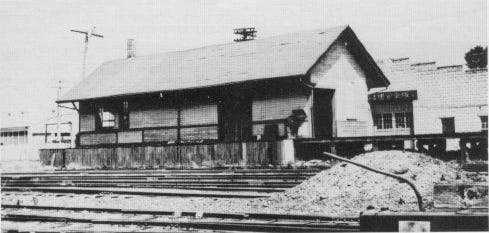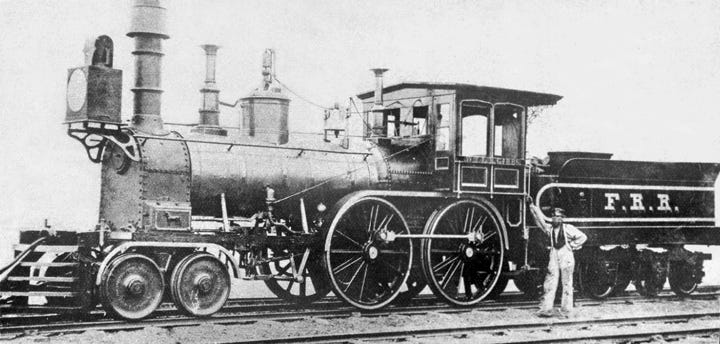The Fairhaven Branch Railroad, 1854 - 1953
For 99 years, trains ran along the route that is now the Phoenix Bike Trail.
One-hundred and seventy years ago, at the end of September, 1854, with the company president Ezekiel Sawin and the superintendent Horace Scott and others aboard, a train of the Fairhaven Branch Railroad traveled the fifteen miles from the Fairhaven waterfront to the Tremont section of Wareham to mark the opening of the line. For the next ninety-nine years, rail service would connect the town to Boston and Cape Cod.
Before the advent of rail transportation, one could travel only on foot, by horse drawn vehicles on rutted dirt roads or by water. A weekly stagecoach traveled to Boston along the post road that led through Acushnet to Taunton. Getting from New Bedford to Taunton took a full day. The New Bedford to Plymouth Mail Stage departed at 10:30 a.m. and arrived at the other end of the route at 5:00 p.m.
It was 1826 before America’s first railway was built in Quincy, MA—a three mile track with horse drawn cars. A steam locomotive first pulled passengers on a train on the Baltimore and Ohio Railroad in 1829 at a speed of 18 miles an hour. Locally, the first line in operation was the New Bedford and Taunton Railroad Company, which was organized in 1838 and started running on July 1, 1840.
The Fairhaven Branch Railroad got its start in May 1849, when a charter was granted to seven local businessmen for the construction of a spur track off the Cape Cod Branch Railroad. The Cape line had begun operation a year earlier, running between Middleboro and Sandwich. The Fairhaven branch would be a side track which would tie the Tremont station to Marion, Mattapoisett and Fairhaven, where a ferry slip at the end of the run would provide connection to New Bedford.
Signed by the Governor on May 1, 1849, Chapter 169 of the Acts of 1849 reads in part: “Nathaniel Church, Warren Delano, Ezekiel Sawin, Zaccheus M. Barstow, Loring Meiggs, Stephen C. Luce, Gilbert Hathaway, their associates and successors, are hereby made a corporation, by the name of the Fairhaven Branch Railroad Company, with all the powers and privileges, and subject to all the duties, restrictions, and liabilities, contained in the forty-fourth chapter of the Revised Statutes, and in that part of the thirty-ninth chapter of said Statutes, relating to railroad corporations, and in all general laws which are now, or may be hereafter, in force, respecting railroads in this Commonwealth.”
The route for the tracks was surveyed in October of 1852 and the contractor for the construction job was selected—Messrs. D.C. Sawin & Co. of Ramapo, NY. One of the first orders of business was exhuming the graves from a 22 foot strip of the Old Burial Ground in the town center. Another act of State Senate and House in 1852 had granted the Fairhaven Branch Railroad permission “to locate and construct its road over the burial ground in the village of Fairhaven,” which was later called Willow Park and is now named Leonard E. Pierce Memorial Park. The bodies were reburied at the new Riverside Cemetery that had been created two years earlier by Warren Delano II, one of the original incorporators of the railroad.
The following spring the work of grading the railroad bed and laying the rails began when 100 workmen from Ireland and iron rails from Wales arrived in April, 1853. The railroad workers were put up in small shacks built along the route.
Rather than have the tracks cross Sconticut Neck Road at grade, it was decided to build a bridge so the trains would run underneath the road. After about a year of toil, the track reached five miles. In April, 1854, a train was run along the route to Mattapoisett, where a celebration ball was held.
The track for the full length of the line was completed in August of 1854. Turntables were installed at both ends of the route. On the Fairhaven waterfront, an old three story wooden building was pressed into service as a station. A brand new, wood-burning steam engine, the W. L. B. Gibbs, arrived from the Hinkley Locomotive Works of Boston. It was followed by a second engine, the Fairhaven. From New York came the new steam ferry Union.
On Monday, October 2, 1854, regularly scheduled trains began running, transporting both passengers and freight. In less than two weeks more than 3,000 people rode the Fairhaven Branch Railroad. (At the time, the total population of Fairhaven, which then included Acushnet, was between 4,000 and 5,000.)
It is interesting to note, a young man who would become one of the most powerful industrialists in the nation and who became the owner of his own railroad line, Henry H. Rogers, took a job as a brakeman and baggage handler on the Fairhaven Branch Railroad before going to Pennsylvania to make his fortune in petroleum. Starting the Wamsutta Oil Company in 1861 was a step up from the railroad job that paid $1.16 a day.
Although the railroad seemed to get off to a successful start, the line seemed to face one calamity after another throughout its history. It almost seems a wonder it lasted ninety-nine years.
First, the country suffered a financial panic in 1857, which hurt the economy for some time. As the Civil War began, kerosene lamps were fast replacing the lamps that burned whale oil and the region’s major industry entered its terminal downward spiral.
Then, there were the fires. The first train station in Fairhaven was destroyed in a blaze in January, 1858. A new depot was built, only to be burned down fifteen months later. Both of the fires had been set. On December 19, 1859, a new brick depot was completed. It was 125 feet long and 50 feet wide, with a projecting roof that extended over the ferry landing to shelter passengers from the weather.
Accidents were quite frequent on the railroad, too, and severe injuries proved fatal to several people, most of whom were employees of the line. William Barstow died after he fell off a moving train while oiling the cylinder on the engine. Alexander Bannon was run over by a handcar. Brakeman Nathan Millet was knocked off a train at Sconticut Neck.
A few mishaps involved cows wandering onto the tracks. Perhaps the worst wreck on the Fairhaven Branch came in 1872 when an engine plowed into a herd of eleven cows and derailed, dragging eight or nine cars off the track with it. The boiler hit an embankment and cars piled onto the engine. Both the engineer, Henry Waldron, and the fireman, Joseph Eldredge, were killed, as were five of the cows. The terrified brakeman, perched in the uppermost of four piled up cars, gripped the brake wheel so tightly that it took three strong men to pry his fingers from it before he could be brought safely to the ground. The passengers and the freight were uninjured.
In 1868, two cows were killed and two more injured when a train ran into them. In 1870, a cow belonging to the train depot watchman Church Holmes was struck by a locomotive. Holmes was paid $96 to replace his animal.
Besides the bad economy and the accidents, the railroad was continually wrangling over the ferry service it was required to maintain. Once horse-drawn trolley service between Fairhaven and New Bedford was begun in 1872, fewer people rode the ferry. The service was discontinued in 1873, but after years of legal battling, the railroad was required by a court order in 1895 to operate a ferry even if it lost money.

The Fairhaven Branch Railroad changed ownership several times. In 1861, it was sold to the New Bedford and Taunton Railroad, which sold it to the Old Colony Railroad. In 1893, it was absorbed into the New York, New Haven and Hartford Railroad. Becoming part of a huge railroad system did nothing to boost the profitability of the small, dead-end spur.
Passenger travel on the railroad began to decline sharply during the first quarter of the Twentieth Century as the automobile became a more affordable and popular mode of transportation. In 1929, the brick railway depot was torn down and the ferry service halted again, this time for good. Passenger service on the Fairhaven line came to an end in 1935.
The Atlas Tack Company and the fishing industry kept the freight operations on the railroad alive for a while longer. After World War II, however, the train ran less and less frequently. In the end, the train was running about three times a week.
In the spring of 1953, the last train rolled out of Fairhaven. The next year, the Town of Fairhaven acquired the railroad right of way from the NY, NH & H.
More than 40 years would pass before the route was to be used again for public transportation.
On April 24, 1999, a ceremony was held to dedicate the Phoenix Bike Trail, built with a grant funded by the Intermodal Surface Transportation Enhancement Act to provide a safe, alternative route for non-motorized travel through town. The trail is now used daily by many people biking, walking, roller skating or running across town.
Plans now underway in Mattapoisett and Marion may one day result in a link from Ferry Street to Tremont being restored.
But there’s a lot less of a chance that you’ll run into cows.
COPYRIGHT 2024 by Christopher J. Richard. All Rights Reserved. This story has been expanded and updated since it originally ran in the Fairhaven’s Monthly Navigator in 2004.







Thanks, Chris! Oh that the rail tunnel still went under SNR— would make for a much easier crossing for everyone. I wonder if the ferry to NB might someday be revived in some form, given the future development of State Pier. Also helpful to know that the rail trail was an ISTEA project— as you’ve noted previously, that means that it needs to be treated (and maintained) as transportation infrastructure and that the intention was for it to be connected to a larger intermodal network. Great piece— I look forward to the next : )
A fascinating story from my hometown's history. I had no idea this happened. Thank you.